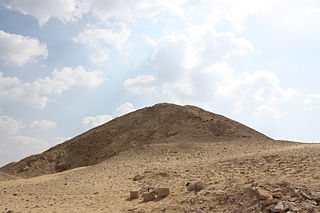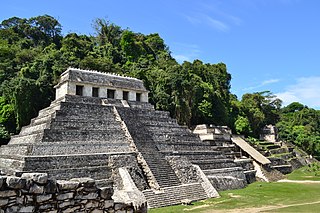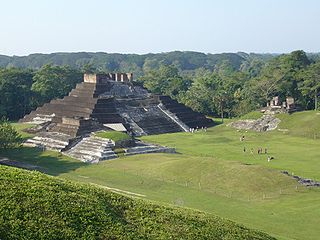
Palenque, also anciently known in the Itza Language as Lakamhaʼ, was a Maya city state in southern Mexico that perished in the 8th century. The Palenque ruins date from ca. 226 BC to ca. 799 AD. After its decline, it was overgrown by the jungle of cedar, mahogany, and sapodilla trees, but has since been excavated and restored. It is located near the Usumacinta River in the Mexican state of Chiapas, about 130 km (81 mi) south of Ciudad del Carmen, 150 meters (490 ft) above sea level. It is adjacent to the modern town of Palenque, Chiapas. It averages a humid 26 °C (79 °F) with roughly 2,160 millimeters (85 in) of rain a year.

Kʼinich Janaab Pakal I, also known as Pacal or Pacal the Great, was ajaw of the Maya city-state of Palenque in the Late Classic period of pre-Columbian Mesoamerican chronology. He acceded to the throne in July 615 and ruled until his death. Pakal reigned 68 years—the fifth-longest verified regnal period of any sovereign monarch in history, the longest in world history for more than a millennium, and still the longest of any residing monarch in the history of the Americas. During his reign, Pakal was responsible for the construction or extension of some of Palenque's most notable surviving inscriptions and monumental architecture. Pakal is perhaps best known in popular culture for his depiction on the carved lid of his sarcophagus, which has become the subject of pseudoarchaeological speculations.
Yohl Ikʼnal, also known as Lady Kan Ik and Lady Kʼanal Ikʼnal, was queen regnant of the Maya city-state of Palenque. She acceded to the throne on 23 December 583, and ruled until her death.

Tomb WV23, also known as KV23, was the tomb of Ay, a pharaoh of the Eighteenth Dynasty, in the Western Valley of the Kings near modern-day Luxor. The tomb was discovered in 1816 by Giovanni Battista Belzoni. Its architecture is similar to that of the royal tomb of Akhenaten at Amarna, with a straight descending corridor leading to a "well chamber" that has no shaft. This leads to the burial chamber, which now contains the reconstructed sarcophagus, which was smashed in antiquity. The tomb had also been anciently desecrated, with many instances of Ay's image or name erased from the wall paintings. Its decoration is similar in content and colour to that of the tomb of Tutankhamun (KV62), with a few differences. On the eastern wall there is a depiction of a fishing and fowling scene, which is not shown in other royal tombs, normally appearing in burials of nobility.

KV20 is a tomb in the Valley of the Kings (Egypt). It was probably the first royal tomb to be constructed in the valley. KV20 was the original burial place of Thutmose I and later was adapted by his daughter Hatshepsut to accommodate her and her father. The tomb was known to Napoleon Bonaparte's expedition in 1799 and had been visited by several explorers between 1799 and 1903. A full clearance of the tomb was undertaken by Howard Carter in 1903–1904. KV20 is distinguishable from other tombs in the valley, both in its general layout and because of the atypical clockwise curvature of its corridors.

Alberto Ruz Lhuillier was a Mexican archaeologist. He specialized in pre-Columbian Mesoamerican archaeology and is well known for leading the National Institute of Anthropology and History (INAH) excavations at the Maya site of Palenque, where he found the tomb of the Maya ruler, Pakal. Ruz Lhuillier is sometimes referred to as the "Hitchcock of Archaeology".

The pyramid of Teti is a smooth-sided pyramid situated in the pyramid field at Saqqara in Egypt. It is the second known pyramid containing pyramid texts. Excavations have revealed a satellite pyramid, two pyramids of queens accompanied by cult structures, and a funerary temple. The pyramid was opened by Gaston Maspero in 1882 and the complex explored during several campaigns ranging from 1907 to 1965. It was originally called Teti's Places Are Enduring. The preservation above ground is very poor, and it now resembles a small hill. Below ground the chambers and corridors are very well preserved.

Neferuptah or Ptahneferu was a daughter of the Egyptian king Amenemhat III of the 12th Dynasty. Her sister was the Pharaoh Sobekneferu.
The pyramid of Pepi I is the pyramid complex built for the Egyptian pharaoh Pepi I of the Sixth Dynasty in the 24th or 23rd century BC. The complex gave its name to the capital city of Egypt, Memphis. As in the pyramids of his predecessors, Pepi I's substructure was filled with vertical columns of hieroglyphic texts, Pyramid Texts. It was in Pepi I's pyramid that these texts were initially discovered in 1880 by Gaston Maspero, though they originated in the pyramid of Unas. The corpus of Pepi I's texts is also the largest from the Old Kingdom, comprising 2,263 columns and lines of hieroglyphs.

The pyramid of Djedkare Isesi is a late 25th to mid 24th century BC pyramid complex built for the Fifth Dynasty pharaoh Djedkare Isesi. The pyramid is referred to as Haram el-Shawaf by locals. It was the first pyramid to be built in South Saqqara.

The Temple of the Inscriptions is the largest Mesoamerican stepped pyramid structure at the pre-Columbian Maya civilization site of Palenque, located in the modern-day state of Chiapas, Mexico. The structure was specifically built as the funerary monument for K'inich Janaab' Pakal, ajaw or ruler of Palenque in the 7th century, whose reign over the polity lasted almost 70 years. Construction of this monument commenced in the last decade of his life, and was completed by his son and successor K'inich Kan B'alam II. Within Palenque, the Temple of the Inscriptions is located in an area known as the Temple of the Inscriptions’ Court and stands at a right angle to the Southeast of the Palace. The Temple of the Inscriptions has been significant in the study of the ancient Maya, owing to the extraordinary sample of hieroglyphic text found on the Inscription Tablets, the impressive sculptural panels on the piers of the building, and the finds inside the tomb of Pakal.
Sesheshet, occasionally known as Sesh, was the mother of King Teti, the first and founding pharaoh of the Sixth Dynasty of Ancient Egypt. She was instrumental in enabling her son to gain the throne and reconciling two warring factions of the royal family.
Temple 20 is a pyramidal building, dated to between AD 430 and 600, located at the Maya city of Palenque in the state of Chiapas in southern Mexico with a funerary chamber that contains remains of a high ranking character. Archaeologist Merle Greene Robertson has suggested that the vaulted tomb under Temple 20 is that of Queen Ix Yohl Ik'nal.

The Temple of the Cross Complex is a complex of temples at the Maya site of Palenque in the state of Chiapas in Mexico. It is located in the south-east corner of the site and consists of three main structures: the Temple of the Cross, Temple of the Sun, and the Temple of the Foliated Cross. The Temple of the Cross is the largest and most significant. The temple is a step pyramid containing bas-relief carvings inside. The temple was constructed to commemorate the rise of Chan Bahlum II to the throne after the death of Pacal the Great. The bas-relief carvings reveal Chan Bahlum receiving the great gift from his predecessor. The cross motif found at the complex allude to the names given to the temples, but in reality the cross is a representation to the World Tree that can be found in the center of the world according to Mayan mythology.

Comalcalco is an ancient Maya archaeological site in the State of Tabasco, Mexico, adjacent to the modern city of Comalcalco and near the southern coast of the Gulf of Mexico. It is the only major Maya city built with bricks rather than limestone masonry and was the westernmost city of the Maya civilisation. Covering an area of 7 km2 (2.7 sq mi), Comalcalco was founded in the Late Classic period and may have been a satellite or colony of Palenque based on architectural similarities between the two. The city was a center of the Chontal Maya people.
The Southern South Saqqara Pyramid is an ancient Egyptian royal tomb which was built during the 13th Dynasty in South Saqqara, and is renowned for having the most elaborate hypogeum since the late 12th Dynasty pyramids. The building remains unfinished and its owner is still uncertain as no unambiguous evidence has been found to settle the issue. In 2008, the Egyptologist Christoffer Theis proposed that the pyramid was built for king Djehuti, based on a inscription discovered nearby by Gustave Jéquier.

Fanny López Jiménez is a Mexican archaeologist known for her excavations at Palenque, including the discovery of the Tomb of the Red Queen.

The pyramid of Senusret III is an ancient Egyptian pyramid located at Dahshur and built for pharaoh Senusret III of the 12th Dynasty.

The Double Pyramid, also known as Lepsius XXV, designates a pair of adjacent monuments located on the south-eastern edge of the Abusir necropolis, south of the pyramid Lepsius XXIV and of the pyramid of Khentkaus II. The pair of monuments was built during the mid-Fifth Dynasty, likely during Nyuserre Ini's reign, for two female members of the extended royal family.
Vera Tiesler is a bioarchaeologist, and a full research professor in the department of Anthroprological Sciences at the Autonomous University of Yucatán in Mexico. She is a specialist in Maya civilization remains.
















